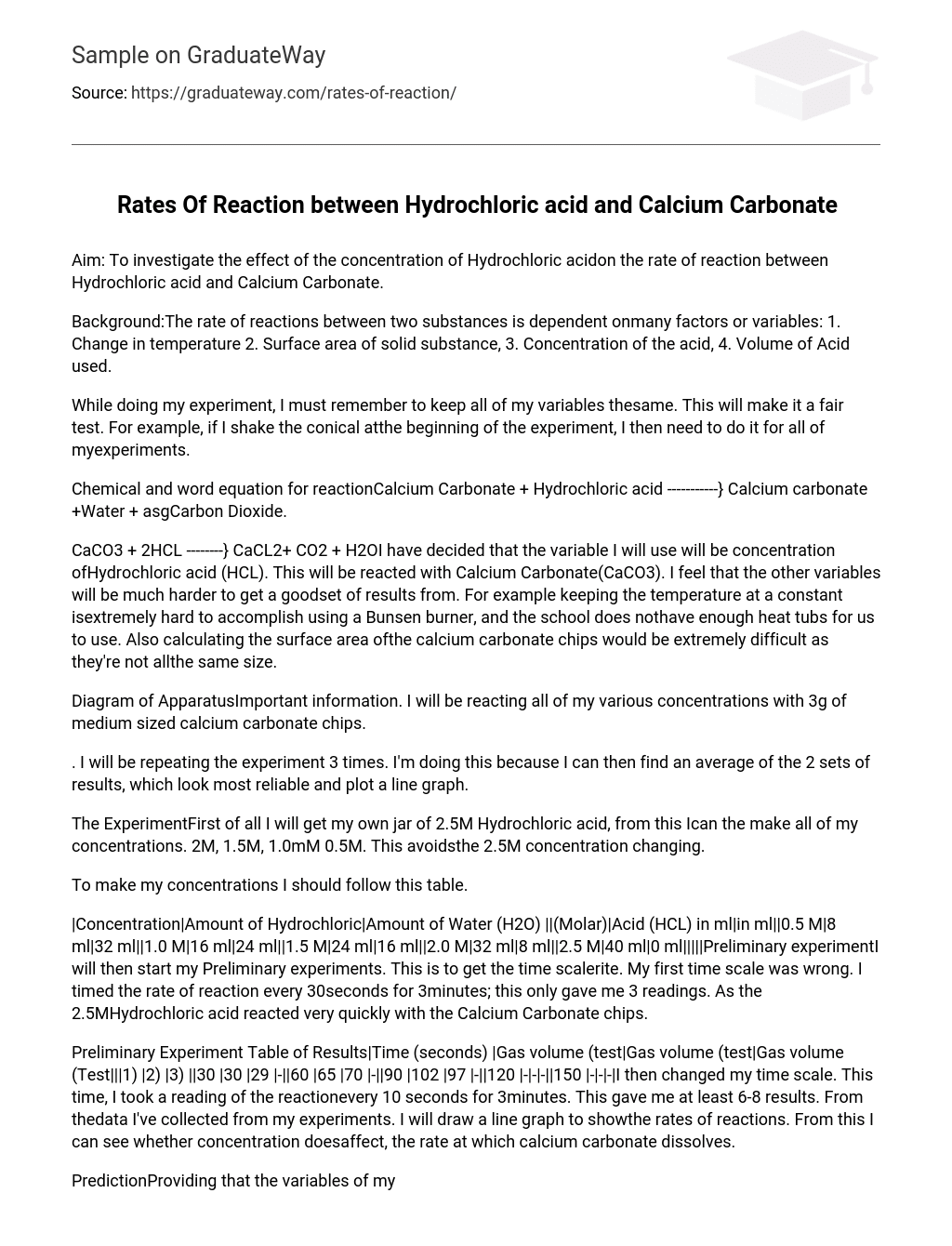Aim: To investigate the effect of the concentration of Hydrochloric acidon the rate of reaction between Hydrochloric acid and Calcium Carbonate.
Background:The rate of reactions between two substances is dependent onmany factors or variables: 1. Change in temperature 2. Surface area of solid substance, 3. Concentration of the acid, 4. Volume of Acid used.
While doing my experiment, I must remember to keep all of my variables thesame. This will make it a fair test. For example, if I shake the conical atthe beginning of the experiment, I then need to do it for all of myexperiments.
Chemical and word equation for reactionCalcium Carbonate + Hydrochloric acid ———–} Calcium carbonate +Water + asgCarbon Dioxide.
CaCO3 + 2HCL ——–} CaCL2+ CO2 + H2OI have decided that the variable I will use will be concentration ofHydrochloric acid (HCL). This will be reacted with Calcium Carbonate(CaCO3). I feel that the other variables will be much harder to get a goodset of results from. For example keeping the temperature at a constant isextremely hard to accomplish using a Bunsen burner, and the school does nothave enough heat tubs for us to use. Also calculating the surface area ofthe calcium carbonate chips would be extremely difficult as they’re not allthe same size.
Diagram of ApparatusImportant information. I will be reacting all of my various concentrations with 3g of medium sized calcium carbonate chips.
. I will be repeating the experiment 3 times. I’m doing this because I can then find an average of the 2 sets of results, which look most reliable and plot a line graph.
The ExperimentFirst of all I will get my own jar of 2.5M Hydrochloric acid, from this Ican the make all of my concentrations. 2M, 1.5M, 1.0mM 0.5M. This avoidsthe 2.5M concentration changing.
To make my concentrations I should follow this table.
|Concentration|Amount of Hydrochloric|Amount of Water (H2O) ||(Molar)|Acid (HCL) in ml|in ml||0.5 M|8 ml|32 ml||1.0 M|16 ml|24 ml||1.5 M|24 ml|16 ml||2.0 M|32 ml|8 ml||2.5 M|40 ml|0 ml|||||Preliminary experimentI will then start my Preliminary experiments. This is to get the time scalerite. My first time scale was wrong. I timed the rate of reaction every 30seconds for 3minutes; this only gave me 3 readings. As the 2.5MHydrochloric acid reacted very quickly with the Calcium Carbonate chips.
Preliminary Experiment Table of Results|Time (seconds) |Gas volume (test|Gas volume (test|Gas volume (Test|||1) |2) |3) ||30 |30 |29 |-||60 |65 |70 |-||90 |102 |97 |-||120 |-|-|-||150 |-|-|-|I then changed my time scale. This time, I took a reading of the reactionevery 10 seconds for 3minutes. This gave me at least 6-8 results. From thedata I’ve collected from my experiments. I will draw a line graph to showthe rates of reactions. From this I can see whether concentration doesaffect, the rate at which calcium carbonate dissolves.
PredictionProviding that the variables of my experiment remain constant I wouldexpect that the amount of CO2 given off would be directly proportional tothe change in concentration. I predict that by increasing theconcentration that the amount of Carbon Dioxide will also be increased. Ithink that by doubling my concentration the amount of gas will be doubled.
This is due to the collision theory. However, depending on theconditions, only a small fraction of the collisions are effective inproducing a reaction. There are several constraints. In order for areaction to occur, bonds initially are broken, which requires energy. Thisenergy depends on the type of the reaction and comes from the kineticenergies that the molecules possess before the collision. It is called theactivation energy. Increasing the temperature increases the kineticenergies and more collisions will occur. In addition, at a highertemperature a greater number of the reacting molecules might possess energyequal to or greater than the activation energy. However the molecules mustalso collide in a specific direction, called the satiric factor in orderfor a reaction to occur. A reaction will only be successful, if thecollision has enough energy to be either equal to or greater than theactivation energy and if the orientation of the collision allows forcorrect bond formation. As I’ am not testing temperature. The moralitywhich I’ am testing will affect the rate of reaction. The increase inconcentration causes there to be more molecules in the solution, whichmeans that collisions are more likely to occur. This increase incollisions will mean that the reaction will reach its optimum rate faster.
Therefore the rate of reaction is faster.





